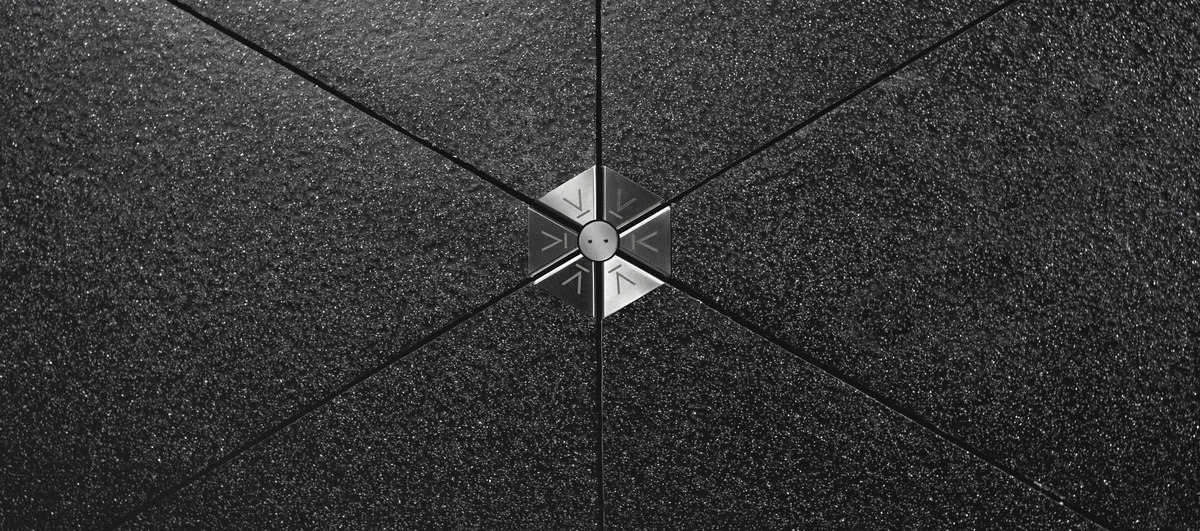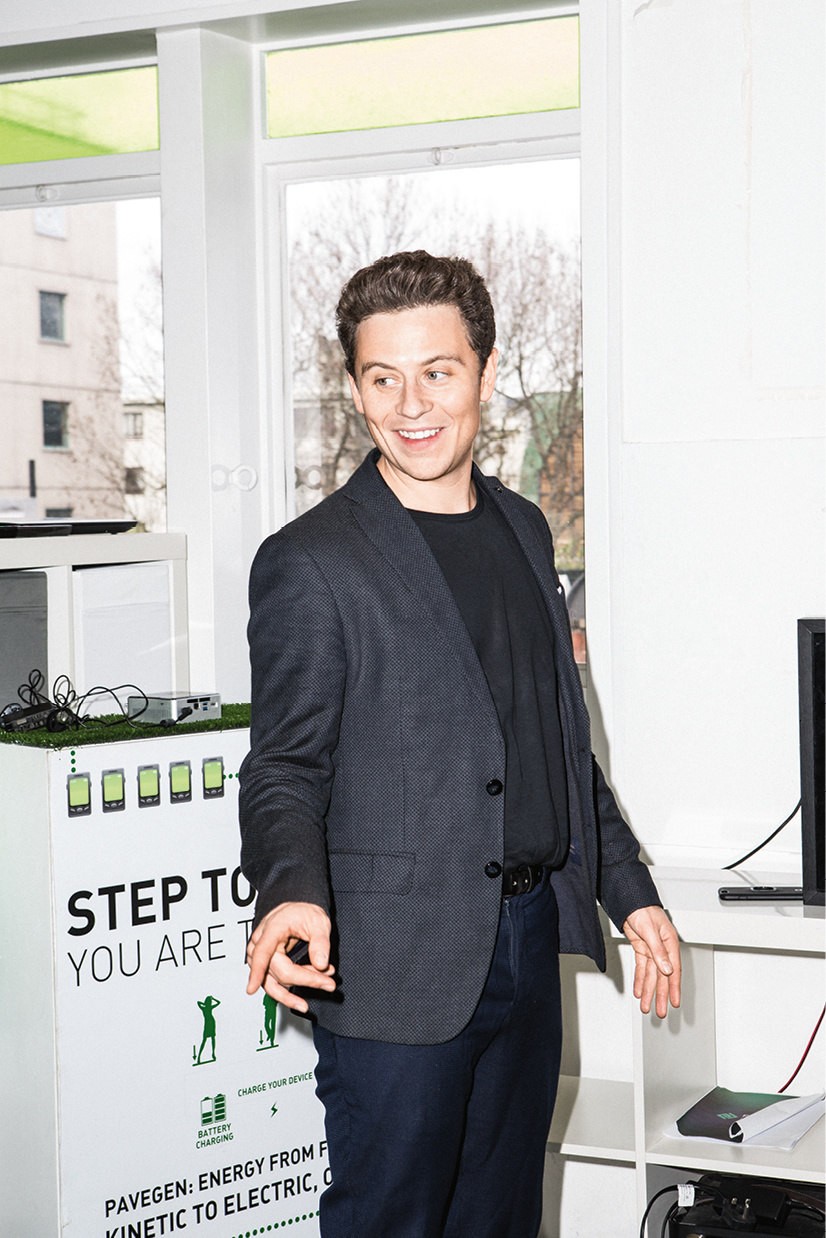
Step by step
Are people the energy source of tomorrow? London-based industrial designer Laurence Kemball-Cook has developed smart floor tiles that convert kinetic energy from footsteps into electricity and data.
Nadine Kaminski (copy) & Jeremy Liebman (photo)

You can’t buy charisma. But you can design it. Interview by interview, performance by performance. Which is how things went for Laurence Kemball-Cook, the creator of Pavegen. He gave himself a complete makeover during the past nine years, going from geeky garage engineer to the impeccably dressed, cosmopolitan ambassador of an appealing, sustainable startup. The idea at the root of his company is as simple as it is brilliant: turn the force of a human footstep into electricity. No wonder this intriguing approach quickly created a stir—which Kemball-Cook enjoyed, despite being new to the limelight. In early public appearances, he looked like a shy straight-A student allowing himself to take restrained pride in his achievement. Today he markets Pavegen as an enthusiastic one-man show so engagingly that many see in him the next Elon Musk: a rock star of digitalization.
Even when he founded Pavegen way back in 2009, however, Kemball-Cook was no awkward techie. Despite his claims of having locked himself away in his tiny London digs for around three years while tinkering with the technology behind Pavegen, for Kemball-Cook, who holds a degree in industrial design and technology, one thing was always paramount: fun. Or more precisely, the philosophy he derived from the concept of fun. He calls it the “gamification of life,” explaining:“You motivate people to keep making progress by creating rewards systems, offering immediate feedback, making abstract values tangible.” He aims to generate a new awareness of resources and individual responsibility—but in a playful way rather than by wagging a finger. Kemball-Cook, now 30, is surrounded by an aura of almost childlike lightness that is the wellspring of his charisma—and kept him from getting discouraged back in the day, before Pavegen’s success story even began. That story, after all, started with a dismal failure.
As a student at prestigious Loughborough University, Kemball-Cook’s work included research for a European energy company, which then awarded him his own project. The task: design urban street lights as a closed system powered by renewable energy. “We operated like a kind of ninja clan within the company,” Kemball-Cook recalls. Naturally, the team first looked to the established resources: wind and sun. “Our ideas were ambitious and expensive,” Kemball-Cook says. He recommended investing heavily in special LED manufacturers and external research contracts—and the company gave him free rein. But after six months, reality caught up with the visionary. None of Kemball-Cook’s carefully thought-out designs were viable; the project went south. “Wind and solar energy are simply not suitable for powering the systems in a large city reliably long-term. Urban canyons are shady and buildings block the wind. We gave up and I left the company with my head hanging.”

Like many proponents of New Urbanism, Kemball-Cook sees big cities as potential quality-of-life meccas. As long as the planning always revolves around people, that is.
Some day, we hope to offer Pavegen for the
same price as regular flooring.

The beginnings in Kemball-Cook’s London apartment.

In 2018, two energy and data harvesting Pavegen walkways integrated with solar panels were the centerpiece of an award-winning sustainable garden at the Chelsea Flower Show in London.
For designer Laurence Kemball-Cook, smart technology and an elegant design concept go hand in hand. Simple to use, inexpensive and avant-garde all rolled into one—Kemball-Cook uses these three ingredients in equal measure. The latest generation of Pavegen flooring tiles works according to a modular building-block system and now features a newly designed logo.
Too late to save the project but just in time to perhaps change the world, inspiration struck while he was waiting for the underground at London’s Victoria Station. London’s Tube stations at rush hour are like beehives, buzzing with human activity and energy. What if you could harness that energy and transform it? The idea behind Pavegen was born. Kemball-Cook certainly had all the necessary know-how. So, with rekindled enthusiasm, he set about implementing it. “Once I had built the prototype, I had to find suitable sponsors as fast as possible.” As a typical millennial with the attitude that visionary thinking and pragmatism need not (and indeed must never) be mutually exclusive, he thought: “Anybody can design something. But designing it so that it can be reproduced infinitely—that’s the mark of design success.” In his view, design at its core is communication. Not an end in itself but a service. Something that makes life easier and improves the world directly. Laurence Kemball-Cook is not a patient person. He had no appetite for spending years knocking on doors or buying the implementation of his vision by forking over 70 percent of his profits to some big-time player. That was when he discovered his talent as a salesman and struck gold with bold guerrilla marketing tactics. “A handful of business angels who believed in us provided the first four million pounds,” he says. “We went into production.” In 2016, another milestone was achieved supported by a crowdfunding initiative, and its success surprised even the ever-optimistic Kemball-Cook: Starting from what was then a square floor tile with a single, footfall-activated flywheel in the center, the Pavegen team developed a three-sided model with a wheel in each corner. “With that, a single step generates up to 200 times more electricity than with our prototype.” Considering the practical applications in shopping centers, airports and pedestrian zones, the triangular model also means less wasted space; the individual tiles mesh together with no gaps, almost like a honeycomb. It uses an innovative click system that’s easier to maintain, generates fewer costs and comes with a 20-year guarantee. This is good news that’s silencing critics one by one. The “gimmick” originally unveiled with great fanfare at technology and light art festivals has now evolved into a viable building block of tomorrow’s smart cities.

“While I was presenting Pavegen locally, I received death threats at first—and then ovations,” Kemball-Cook says of his trip to Rio’s favelas. That was the setting where, accompanied by a huge media buzz, he installed one of his pilot projects: floodlights for a soccer field in one of the world’s poorest, most dangerous neighborhoods. “The kids were drawn in by their love of soccer—and I got many of them to share my enthusiasm for technology and design.”
The technology behind Pavegen is based on a kind of pedal principle. Pressure exerted on the surface sets three coils in motion that work like a tiny windmill.
Bird Street, just off Oxford Street with its nonstop bustle of foot traffic, is London’s first smart street. During 2017 pedestrians were able to generate energy for street lighting, sounds and data collection, thanks to Pavegen. Several meters’ worth of Pavegen surface were installed near the White House in Washington, D. C. in 2017, along with another area in a shopping mall on the outskirts of London in spring 2018. The first public installations were along the lines of a show or a PR stunt, such as the layer that was placed under soccer turf in Rio de Janeiro’s favelas so the players could operate the floodlights themselves—though they still required a boost from solar panels on the surrounding buildings’ roofs. Nowadays, project by project, Pavegen is taking on ever more practical forms. Kemball-Cook recently signed a memorandum with technology giant Siemens in an effort to expand his global footprint even further with the company’s help. The collaboration will target airports and hospitals. “Some day, we hope to offer Pavegen for the same price as regular flooring,” Kemball-Cook says confidently. The young entrepreneur captivates sponsors, politicians and NGOs alike—especially due to his total lack of extravagance. His drive as a designer is the same force that unites all the successful architects of our daily lives: Design and technology should serve people and only people. For quite some time, he has been using lectures and podium discussions to preach about the “Internet of Beings” as a more advanced iteration of the Internet of Things.
Kemball-Cook still firmly believes in motivation through gamification. “That’s why Pavegen was well accepted from the outset,” he states. “Because seeing the immediate results of your actions is fun.” You take a step, a light goes on. You walk along a Pavegen surface and you can decide via an app where the energy you are generating goes. Want to light up the facade of your favorite café? Or donate the power to a good cause? “Using a permission-based system to reward people for their footsteps is our goal for the months to come,” Kemball-Cook explains. Pavegen’s designers are working flat-out to deliver ever more digital benefits; there is no end to their ideas for ways to use the product. After all—and this could be a crucial help with the planning of whole smart cities in the future—Pavegen systems contain low-power bluetooth be cons which transmit data about movement patterns, providing an idea of peak times for foot traffic and consumer behavior. Another possible next step: the automotive world. Theoretically, vehicles could use the Pavegen principle to generate many times more energy with the pressure they create when stopping on the road surface. The charitable gamification of mobility: What’s not to love about that vision?

Astana, the capital of Kazakhstan, is now on the way to joining the ranks of the world’s top 50 smart cities. The headquarters of the country’s largest construction company had the latest generation of Pavegen tiles installed in 2017.
More than 2,000 investors have now gotten behind the project. According to Kemball-Cook, interest has been expressed in another 1,000 installations around the globe. Over 200 sites in 30 countries currently feature Pavegen panels.